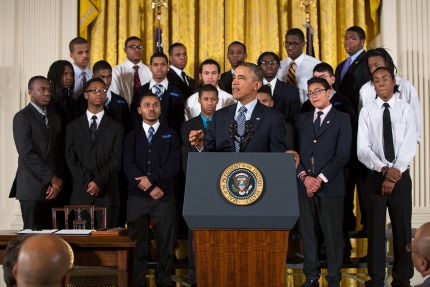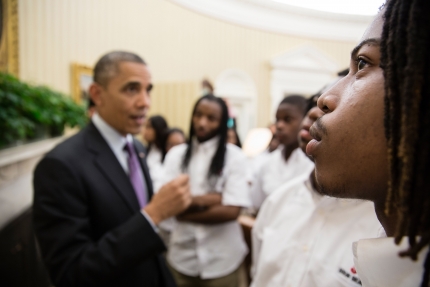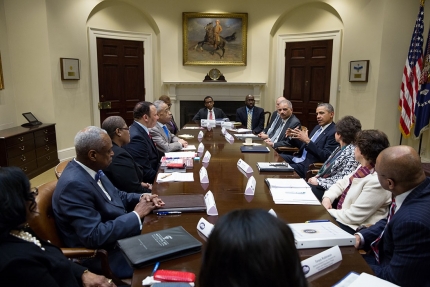Blog Posts Related to the African American Community
1890 Historically Black Land-Grant Colleges and Universities: Ensuring Access to Higher Education and Opportunity for All
Posted by on February 28, 2014 at 4:52 PM EDTEd. note: This is cross-posted from USDA.gov
Earlier this week I caught up with Tom Joyner on the Tom Joyner Morning Show to announce $35 million in grant support for high quality research, teaching and Extension activities at 1890 Historically Black Land-Grant Colleges and Universities. Tom, a graduate of Tuskegee University, and I discussed how these additional resources will help support exciting new opportunities and innovative research at 1890s institutions.
These grants are just a small piece of USDA’s nearly 125 year partnership with 1890s schools to support cutting edge research, innovation and student achievement. Since 2009 alone, USDA has awarded $647 million to 1890s schools.
In addition to highlighting the great work of these universities with Tom Joyner, I also joined Congresswoman Marcia Fudge—a champion of education and an extraordinary advocate for underserved Americans—to announce the designation of Central State University, a historically black university in Wilberforce, Ohio, as a land-grant institution.
Beginning in fiscal year 2016, Central State University will be eligible to receive USDA funding to strengthen its capacity to conduct research, Extension and teaching activities. In the meantime, the university is currently eligible to apply for certain USDA competitive grants and students can apply for scholarships through USDA’s 1890 National Scholars Program (applications are due by March 14, 2014).
Partnerships with 1890s institutions are critical for two reasons.
First, working closely with 1890s institutions allows us to work more directly with the next generation of agricultural leaders. Whether they are destined for careers in communications, research, technology, and education, or to work directly in the field as farmers, ranchers, foresters and conservationists, it is important that we build strong relationships early on.
For example, at Southern University in Baton Rouge, Louisiana, scientists used USDA support to start a program to equip youngsters with the critical thinking skills necessary to prepare them for future careers. This project has increased the number of students entering food and agricultural sciences and in turn benefits rural communities, and all Americans.
Second, these partnerships further our broader mission at USDA to ensure equal access to programs and services for all of our stakeholders.
We’ve made significant progress to create a new, lasting era of civil rights at USDA: We have undertaken an initiative to focus civil rights trainings in agencies with large program complaint filings, which has resulted in three consecutive years of the lowest total volume of customer civil rights complaints in USDA’s Farm Service Agency (FSA), Natural Resources Conservation Service (NRCS), and Rural Development (RD).
We’ve settled lawsuits brought by African American farmers in Pigford II, and by Native American ranchers and farmers in Keepseagle. We have constructed a unified claims process to provide a path to justice for Hispanic and women farmers and ranchers who claim to have faced discrimination by USDA in past decades.
I am proud of what we’ve accomplished, but our work is not finished. We will continue to work towards a more diverse Department that stands ready to serve all customers with dignity and respect, and build a new legacy of equality, service and opportunity for all.
Tom Vilsack is Secretary of the United States Department of Agriculture.
Learn more aboutChampion of African American History: The Honorable Shirley Chisholm of New York
Posted by on February 28, 2014 at 3:41 PM EDT“I don't measure America by its achievement but by its potential.” – Shirley Chisolm, in her book, “Unbought and Unbossed”
With her slight build, distinctly precise diction, and relentless energy, Representative Shirley Chisholm of New York will be forever remembered for the ground she broke in Congress, and the ground she laid for millions of women, girls, and African Americans in this country.
In honor of her contributions as the first African American woman elected to the U.S. Congress, and a tireless advocate for women, African Americans, and folks who are all too often overlooked or underserved, the U.S. Postal Service has recognized Ms. Chisholm with the issuance of their limited-edition 37th Black Heritage Forever Stamp.
Born in Brooklyn in 1924, Shirley Chisholm’s childhood was split between New York and Barbados, where she lived with her grandmother. Upon graduating from Brooklyn College in 1946, she pursued a career in teaching, eventually earning a master’s degree in elementary education from Columbia University. She later served as a childcare center director, and an educational consultant for New York City’s Bureau of Child Welfare.
Shirley Chisholm was elected in 1968 as a member of the U.S. House of Representatives, representing New York as the first African American Congresswoman in that history. She spent seven terms in Congress fighting for social justice and access to quality education for all, while championing the rights and empowerment of women, African Americans, the poor.
In addition to serving on the Education and Labor Committee, and the Veterans’ Affairs Committee, Chisholm was also one of the founding members of both the Congressional Black Caucus, and the National Organization of Women, while playing a key role the passage of Supplemental Nutrition Assistance Program (SNAP) legislation.
“Tremendous amounts of talent are lost to our society just because that talent wears a skirt.”- Shirley Chisolm
In 1972, Chisholm became widely known across the country when she became the first African American to seek a major party’s nomination for President of the United States. In doing so, she challenged countless norms and shattered innumerable barriers which had stood since the dawn of our republic. And it was far from easy. She had to sue her way into televised debates, and survived multiple assassination attempts along the way. Ms. Chisolm did not earn the Democratic Party’s nomination in 1972, but she did earn a place in history, along with the boundless respect of millions of Americans for her fundamental refusal to live life within the confines of society’s expectations. Through her example, future generations gain a better appreciation for what it means to control one’s own destiny.
When she left Congress in 1983, Chisholm returned to teaching, accepting a post at Mount Holyoke College. She died on January 1, 2005 in Ormond Beach, Florida, at the age of 80.
According to the U.S. Postal Service, the stamp was designed using a painting of Chisholm by artist Robert Shetterly. The portrait is taken from a series of paintings titled “Americans Who Tell the Truth.”
Valerie Jarrett is Senior Adviser to the President and Chair of the White House Council on Women and Girls.
Learn more about Civil RightsPresident Obama Launches My Brother's Keeper, His New Initiative to Help Young Men of Color
Posted by on February 27, 2014 at 8:32 PM EDTThis afternoon, in the East Room of the White House, President Obama delivered remarks at the launch event for My Brother's Keeper -- his new initiative aimed at helping young men and boys of color facing tough odds reach their full potential. The initiative will bring together private philanthropies, businesses, governors, mayors, faith leaders, and nonprofit organizations that are committed to helping them succeed.
As the President said in today's remarks, ensuring that young men of color can reach their full potential is the only way "America can reach its full potential."
President Obama announced that philanthropies and corporate leaders have pledged to invest at least $200 million over the next five years -- on top of $150 million that they have already invested -- to figure out which programs are the most successful in helping young men of color and replicate them in communities across the country. He also signed a presidential memorandum directing the federal government to determine the best methods to improve the odds for young men of color.
Learn more about EducationMy Brother’s Keeper: A New White House Initiative to Empower Boys and Young Men of Color
Posted by on February 27, 2014 at 11:26 AM EDTToday, from the East Room of the White House, President Obama will launch a new effort aimed at empowering boys and young men of color, a segment of our society which too often faces disproportionate challenges and obstacles to success. These obstacles are found in our schools, our communities, our criminal justice system, our families, and even in the minds of our young people themselves. The President is committed to build a broad coalition of backers to help break down barriers, clear pathways to opportunity, and reverse troubling trends which show too many of our boys and young men of color slipping through the cracks in our society.
To launch the “My Brother’s Keeper” initiative, the President will be joined by local and national leaders in philanthropy, business, government, faith communities, and media. The challenges facing boys and young men of color are broad and multidimensional, and so must be the team we bring to the table to begin fostering solutions.
On hand today will be General Colin Powell, Mayor Michael Bloomberg, Adam Silver, Congresswoman Marcia Fudge, Mayor Rahm Emanuel, Congressman Ruben Hinojosa, Magic Johnson, and many more leaders from key national and regional philanthropic foundations and major businesses, all of whom understand what is at stake with this effort. When we let this many boys and young men fall behind – we are crippling our ability to reach our full potential as a nation.
Learn more about Education, Urban PolicyWe the Geeks: Celebrating Black History Month
Posted by on February 21, 2014 at 1:45 PM EDTWe at the White House couldn’t be more excited to celebrate Black History Month by highlighting some of our nation’s most prominent and promising African American science, technology, engineering, and mathematics (STEM) achievers and shining a light on the importance of ensuring the Nation’s next generation of inventors, discoverers, and innovators fully reflects the diversity of America.
Members of racial and ethnic minority groups are projected to become the majority of America’s population in the next 30 years. Today, however, they account for just 28 percent of America’s STEM workers. We know that for America to remain competitive in a global economy, we need to do all we can to draw upon the nation’s diverse talent pool, which includes historically underrepresented groups in STEM, such as women and minorities.
That’s why, next week, OSTP is hosting and participating in a series of activities to highlight diverse STEM role models and the urgent need to help minority students across the country envision themselves as tomorrow’s discoverers, explorers, developers, and STEM innovators.
To kick off our week of activities, join us Tuesday, February 25 at 3:00 pm EST for "We the Geeks: Celebrating Black History Month"
In this Google+ Hangout, some of the Nation’s most extraordinary African American STEM innovators and STEM-education advocates will share their inspiring personal stories and thoughts on how we can all step up to help strengthen America’s STEM-skilled workforce by making it broader and more diverse.
Partnering for Action in African American Communities
Posted by on February 19, 2014 at 11:20 AM EDTLeaders from some of the country’s foremost African American civil rights organizations joined President Obama and a handful of Administration leaders in the Roosevelt Room of the White House yesterday. To open the meeting, I was joined by Attorney General Eric Holder, Director of the Domestic Policy Council Cecilia Muñoz, Cabinet Secretary Broderick Johnson and White House Advisor for Health Policy and Implementation Phil Schiliro for a discussion outlining the President’s priorities for this year of action.
Present were leaders from the NAACP, The National Urban League, the National Action Network, the NAACP Legal Defense Fund, the Leadership Conference on Civil and Human Rights, the National Bar Association and the National Coalition of Black Civic Participation. The group covered a range of issues of great concern to the President, and the African American community, touching on job growth, education and job training, maintaining our momentum in enrolling the uninsured through the Affordable Care Act, bringing more fairness and efficiency to our criminal justice system, increasing the minimum wage, and ensuring ladders of opportunity for all.
What was clear in this meeting was that many of the goals the President set forth in his State of the Union address will become reality because of the strong partnerships that he and his administration have forged with leaders from the civil rights community who work hard every day to advocate equality and opportunity for all.
The President will continue to work with Congress where they are able and willing to act, but meetings like this provide optimistic reminders that there remain other leaders in the country who can act right now – to improve the economy, to ensure greater opportunity for all, and to keep this country moving in the right direction. The capacity for the President and his White House to convene thought leaders, decision makers, and community leaders, all of whom have access to both resources and the audiences we aim to reach, is a powerful tool, and one which President Obama hopes to wield effectively in 2014 for the good of all Americans.
Valerie Jarrett is Senior Advisor to the President and Chair of the White House Council on Women and Girls
Learn more about Civil Rights
- &lsaquo previous
- …
- 5
- 6
- 7
- 8
- 9
- 10
- 11
- 12
- 13
- …
- next &rsaquo




